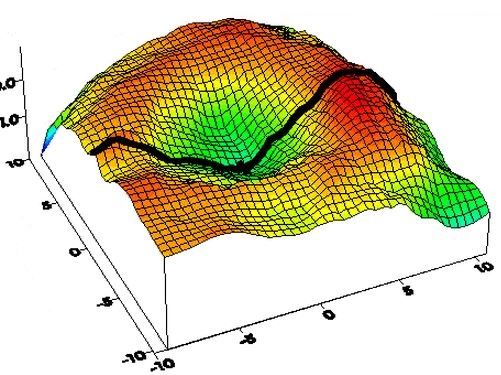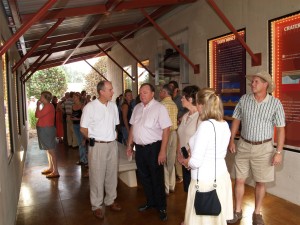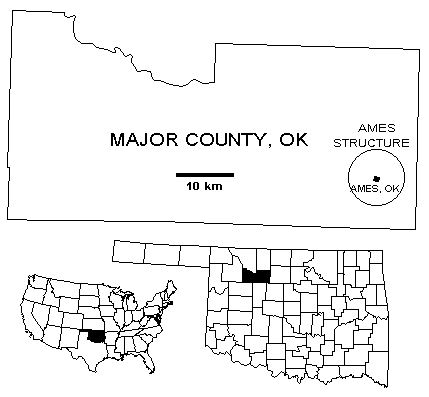A 1991 Oklahoma oil discovery in a hidden meteor crater attracted worldwide attention.
About 450 million years ago, a meteor about the size of a football struck north-central Oklahoma, creating an impact crater — an astrobleme — more than eight miles wide.
The small town of Ames (population 183 at the 2020 census) proudly claims the crater as its own – and as a significant contributor to the geological knowledge of the nation’s petroleum industry.

The 1991 discovery of oil at Oklahoma’s Ames Crater impact site led to five other oil-producing craters in the United States.
As•tro•bleme (noun) – A depression, usually circular, on the surface of the Earth that is caused by the impact of a meteorite — astro- + Greek blçma “wound from a missile.”
Located about 20 miles southwest of Enid, the Ames astrobleme is buried by about 9,000 feet of sediment, making it barely visible on the surface. The impact crater remained unrecognized until 1991, when a prolific oilfield was discovered by Continental Oil Company.
On August 18, 2007, Ames citizens celebrated the historic discovery by opening of their Ames Astobleme Museum describing the small meteor’s large impact.

A meteorite hit Oklahoma 450 million years ago, producing a crater thousands of feet deep and eight miles wide. Image courtesy Judson Ahern, Oklahoma University.
The museum design includes an open-ended, A-frame structure that requires no staff, according to independent producer Lew Ward, founder of Ward Petroleum in Enid. He was among those who drilled successfully in a region known as the Sooner Trend in the early 1960s.
A former chairman of the Independent Petroleum Association of America (IPAA), Ward helped establish the Ames museum — and also was instrumental in building a new heritage center in Enid.
“The Ames Astrobleme is one of the most remarkable and studied geological features in the world because of its economic significance,” Ward noted in 2007.
The small museum remains open 24 hours. It features high-tech, all-weather video panels on its north and south walls. The panels describe the crater’s formation…and its geological significance, which was revealed by a leading independent producer in the early 1990s.

The Ames Astrobleme Museum features all-weather automated video panels to educate visitors. Photo by Bruce Wells.
One of the videos includes comments from the man who defied the experts and discovered oil in the crater – Enid independent producer Harold Hamm, CEO of Continental Resources, and a friend of Ward.
Both Hamm and Ward were awarded the petroleum industry’s Chief Roughneck Award (Ward in 1999 and Hamm in 2016), given annual since 1955 — until discontinued in 2019 — at the annual IPAA meetings.
Impact of Harold Hamm
Many geologists had believed impact craters unlikely locations for petroleum. Hamm, who had drilled wells in the Ames area since the early 1960s, thought otherwise. Although wells had been drilled nearby, no one had attempted to reach deep into the crater.

The man who found oil in the Ames crater, Harold Hamm (center) spoke at the Astrobleme Museum’s opening in August 1992. Photo courtesy Cherokee Strip Regional Heritage Center.
In 1991, a geologist at Continental Resources found something unusual in the site, so the company drilled a deeper than the normal well – about 10,000 feet – and struck oil. Initial production from this first well was about 200 barrels a day.
According to the American Association of Professional Geologists (AAPG), the potential for petroleum production from impact craters “seized the attention of the Oklahoma oil industry in the early 1990s. Several new, deep wells in the Sooner Trend produced exceptional amounts of oil and gas.”
Since the historic Continental Resources 1991 oil discovery, many more wells have been completed in the Ames astrobleme, some wells producing more than a million barrels of oil. In 1994, the combined flow from three of the company’s wells averaged more than 2,000 barrels of oil and 730,000 cubic feet of gas per day.
By the end of 2006, cumulative production at the Ames astrobleme in Major County showed oil production from the Arbuckle geologic formation alone approached 11 million barrels, noted Parwest Land Exploration, Inc., in a May 2007 report.

The crater “is one of the most remarkable and studied geological features in the world because of its economic significance.” Image courtesy Judson Ahern, University of Oklahoma.
The Ames impact site — one of only six producing craters in the United States — was among the largest oil-bearing craters, yielding 17.4 million barrels of oil and 79.5 billion cubic feet of natural gas by 2007. The Oilfield Review noted in 2009, “Ultimate recoverable reserves are estimated at 25 million barrels of oil and 100 billion cubic gas.”
As the primary developer of the Ames Astrobleme Museum, Hamm spoke at the August 18, 2007, dedication ceremony during the annual Ames Day, a fundraising event for the local volunteer fire department.
The museum dedication ceremony included Bert Mackie, vice chairman of Security National Bank, who grew up in Ames and was the first to advocate promoting the crater’s historical significance. Mackie introduced Charles Mankin, director of the Oklahoma Geological Survey (OGS), who described the crater’s significance for the citizens of Ames, geologists, and worldwide petroleum history.
Editor’s Note – Article adapted from stories in the Enid News & Eagle in 2007, and the AAPG Explorer, March 2002. Llewellyn “Lew” O. Ward III (1930-2016) was an early supporter of the American Oil & Gas Historical Society. He led the campaign to establish the Cherokee Strip Regional Heritage Center in Enid.
_______________________
Recommended Reading: Groundbreakers: The Story of Oilfield Technology and the People Who Made it Happen (2015); Oil in Oklahoma (1976); Oil And Gas In Oklahoma: Petroleum Geology In Oklahoma
(2013); The Oklahoma Petroleum Industry
(1980). Your Amazon purchase benefits the American Oil & Gas Historical Society. As an Amazon Associate, AOGHS earns a commission from qualifying purchases.
_______________________
The American Oil & Gas Historical Society (AOGHS) preserves U.S. petroleum history. Please become an AOGHS annual supporter and help maintain this energy education website and expand historical research. For more information, contact bawells@aoghs.org. © 2024 Bruce A. Wells. All rights reserved.
Citation Information –Article Title: “Ames Astrobleme Museum.” Authors: B.A. Wells and K.L. Wells. Website Name: American Oil & Gas Historical Society. URL: https://aoghs.org/energy-education-resources/ames-astrobleme-oil-museum. Last Updated: August 9, 2024. Original Published Date: December 1, 2007.



